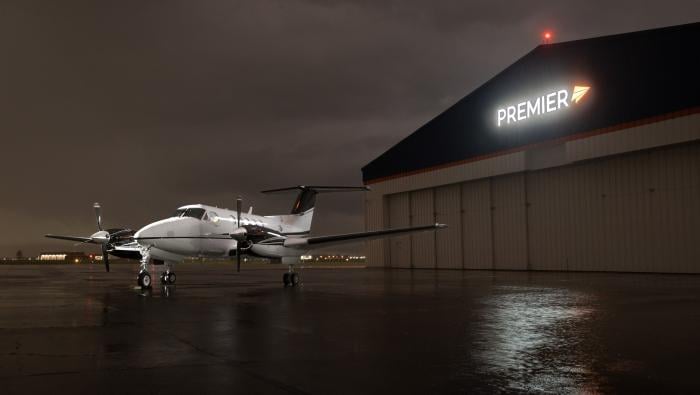|
Three years after the Biden Administration issued its SAF Grand Challenge to the U.S. fuel industry to reach a goal of three billion gallons of neat sustainable aviation fuel (SAF) production a year by 2030, the industry is stepping up. “When we initially set it, there was a lot of discussions about whether that was too ambitious," Alejandro Moreno, an official with the DOE’s Office of Energy Efficiency, said this morning at the North American SAF Conference and Expo in St. Paul, Minnesota. “We are now on track at the low end to meet it and even exceed it.” In 2021, the U.S. produced five million gallons of SAF, and in the first six months of 2024 alone, that number has jumped to 52 million gallons as production facilities continue to come online. In the panel session—a rare occasion that featured senior officials from the Departments of Energy, Agriculture, and Transportation—words such as “enthusiastic, optimistic, and proud” were used by the officials to describe their feelings on the progress. "SAF is the only thing available today that can fit with today’s aircraft and today’s airports with today’s infrastructure,” said Annie Petsonk, the assistant secretary for aviation and international affairs with the DOT. |
|
|
Duncan Aviation has completed the first installation of a Gogo Galileo HDX electronically steered antenna on a Bombardier Challenger 300, and flight testing of the low-earth-orbit satellite communications system has commenced. Gogo Business Aviation also unveiled system and service pricing for Galileo, which will launch commercially later this year. Gogo Galileo runs on the Eutelsat OneWeb satellite network. The HDX is the smaller of two antennas that Gogo will offer, weighing 21.6 pounds and measuring 24 inches long, 11.8 inches wide, and 2.1 inches high. The larger FDX will be available in the first half of 2025 and weighs 40 to 45 pounds, with a length of 30 inches, width 24.6 inches, and height the same at 2.1 inches. Between the two sizes, Gogo said its antenna options will enable Galileo service “on any size business aircraft.” Service speed for the HDX system is up to 60 Mbps download and 11 Mbps upload, while the FDX will offer 195 Mbps download and 32 Mbps upload. Service pricing starts at $3,500 per month for 25 GB to $10,500 for unlimited data. The system price as an add-on to Avance L5 is $120,000 for HDX or $190,000 for FDX. There are eight Galileo supplemental type certificate programs underway, which will cover 5,318 airplanes, and another 21 programs are in process that will cover an additional 12,267 airplanes. |
|
|
West Star Aviation is celebrating the graduation of its inaugural class of its academy established in January as the MRO looks to build the pipeline of its next generation of workers. Formed in partnership with Southwestern Illinois College (SWIC), West Star Aviation Academy (WSSA) graduated an initial class of 23 and has welcomed the next 25 students who will complete their coursework and hands-on training in second-quarter 2025. The graduating class marks a key milestone in West Star’s innovative approach to developing its workforce, the company said. Under the program, prospective apprentices are screened, interviewed, and hired into a full-time paid position. The participants must complete a customized Part 147 airframe maintenance curriculum in a dedicated West Star classroom and hangar over 7.5 months. By undergoing a tailored curriculum, graduates are prepared to join the MRO with hands-on experience with West Star’s aircraft, systems, manuals, and procedures. “We’ve learned a massive amount about how aircraft work, how to repair them, and how to perform maintenance. The knowledge we’re gaining is very applicable to our work,” said David Magg, the first student to test and pass his airframe license through WSAA. As WSAA kicks off training for its second group of apprentices, the company is eyeing future expansions of the program as it continues to grow rapidly. West Star said such announcements will be forthcoming over time. |
|
|
Two years after Guam-based Hansen Helicopters and its owner, John D. Walker, were convicted on multiple federal felony counts related to illegal operations, the U.S. government is suggesting that the company could be continuing to operate in violation of court orders. In a case status report filed with Guam Federal District Court by prosecutors last month, the government accused Hansen of importing three Hughes 369 airframes into Guam as “used parts” from Japan Marine Service in July. Customs documents listed the helicopters as being leased by Pacific Spotters, an entity formed by Walker in the Philippines following his and Hansen’s initial indictments in 2018. Walker, who has been incarcerated since his 2022 conviction, has been ordered to divest of all aviation holdings, including Pacific Spotters, of which he is currently a part-owner. The helicopters in question were operated off Japanese fishing boats, potentially in violation of the court order. Prosecutors also raised concerns about the N-numbered helicopters’ inspection status and whether Hansen intended to repair and maintain them, also a violation of the court order. Pacific Spotters has denied doing any business with the fishing boat companies where the helicopters were based, owning the helicopters, or importing them into Guam. Prosecutors characterized this as “misrepresentations” based on forms submitted to Guam Customs. |
|
|
Sponsor Content: PremierMRO The art of the pre-buy inspection: An expert pre-buy spares new owners many headaches, and potentially high post-sale costs. Sales go more smoothly, with discrepancies resolved to buyer and seller satisfaction. PremierMRO has been conducting win-win pre-buys for decades. It’s a full-service center with expertise on most popular models. |
|
|
AMAC Aerospace has begun work to expand its maintenance, repair, and overhaul (MRO) facility in Turkey. The Swiss-based aircraft completions and MRO group announced today that it has secured an additional 32,000 sq m (eight acres) of land at Milas–Bodrum Airport (LTFE) on which to build hangars that can handle widebody aircraft, as well as technical and administrative facilities. Once construction plans are completed, work will begin immediately and AMAC aims to have the added facilities fully operational in 2026. The company is modeling the Bodrum center on its main facility at Basel Airport. AMAC, which was formed in 2007, conducts cabin completions and MRO services for multiple aircraft types, including extensive experience with widebody models. In Turkey, it already has a facility at Istanbul Atatürk International Airport that specializes in supporting Dassault Falcons, as well as Pilatus PC-12 turboprops and PC-24 jets. The group also includes Zurich-based AMAC Corporate Jet, a management and charter division that operates a fleet of 12 aircraft. In France is its JCB Aero subsidiary that specializes in composite and carbon fiber manufacturing. AMAC Aerospace group executive chairman and CEO Kadri Muhiddin said the company’s investment at LTFE is set to yield social and economic benefits to the area. |
|
|
The Minnesota SAF Hub—a coalition of more than 300 businesses, universities, cities, counties, and philanthropic organizations in the Minneapolis-St. Paul area—noted several milestones in the year since it was established to create the first large-scale sustainable aviation fuel (SAF) value chain in the U.S. Ahead of the North American SAF Conference this week in St. Paul, the group announced the launch of the first SAF blending facility in the state. Flint Hills Resources is collaborating with Delta Air Lines, which has a major hub at Minneapolis-Saint Paul International Airport (KMSP), to develop a plant capable of blending up to 30 million gallons of neat SAF a year. Expected to be completed by the end of 2025, it is believed to be the first facility in the central U.S. with blending capability. The fuel will be delivered via existing pipeline to KMSP. Last month, the FAA awarded a nearly $17 million grant to convert an existing Gevo ethanol and isobutanol fuel refinery in the state into a fully integrated alcohol-to-jet-fuel facility, which will allow it to use Minnesota-grown feedstocks for the first time. To spur production and drive down the cost of SAF, the Hub has established a “demand consortium” that includes companies such as Delta, Bank of America, Deloitte, and Ecolab that would purchase millions of gallons of SAF a year starting in late 2025. |
|
|
The National Air Transportation Association (NATA) asked the FAA to clarify certain references in draft Advisory Circular AC 43-D on maintenance recordkeeping to ensure alignment with FAA regulations. In comments on the draft AC, NATA also recommended that the agency develop a tool that could enable the immediate recall of all issued forms as needed. Updating current guidance in use since 1998, the draft AC would provide acceptable means of compliance for general aviation maintenance record-making and recordkeeping. The FAA in August extended the comment period for the draft AC until October 18 at the request of 11 trade associations, including the Aeronautical Repair Station Association (ARSA), Aircraft Electronics Association, Aircraft Owners and Pilots Association, and General Aviation Manufacturers Association, along with NATA. ARSA noted, “Though not regulatory—it provides a method, not the only method for showing compliance—the industry continues to push the FAA to carefully align its guidance with the regulations.” In their request for the extension, the associations stated: “The document contains changes that must be reviewed carefully to ensure compliance with both Parts 43 and 91, while accommodating the proper method for completing an FAA Form 8130-3. To use an FAA Form 8130-3 as a maintenance record, information on its completion must be reconciled with the elements required by §43.9 and multiple bilateral agreements, maintenance implementation documents, and other advisory material.” |
|
|
With the winter months just around the corner in the Northern Hemisphere, the NTSB has published Safety Alert SA-097 to remind operators of the risks of flying in icing conditions, including the adverse effects of airframe and propeller icing on aircraft performance. “As little as one-quarter inch of wing leading-edge ice accumulation can increase the stall speed by 25 to 40 knots and cause sudden departure from controlled fight,” warns the NTSB. In addition, ice accumulation on pitot tubes can cause flight instruments—particularly airspeed, altimeter, and vertical speed indicators—to stop functioning or give incorrect readings. The notice concedes that some pilots have been taught to wait for a prescribed accumulation of leading-edge ice before activating deice boots because of the threat of ice bridging. “However, performance degradation could develop if the deice boots are not activated as soon as icing is encountered.” The notice also cautions that continuous use of the autopilot in icing conditions can “deprive the pilot of the opportunity to detect the buildup of ice on the airframe through changes in longitudinal trim requirements and control forces.” The fatal crash of an Embraer Phenom 100 on Dec. 8, 2014, was one of several icing accidents cited in the notice where the NTSB said pilots “did not adequately comply” with instructions in their pilot operating handbooks or aircraft flight manuals leading to inflight loss of control. |
|
|
|
|
|
|
AINalerts News Tips/Feedback: News tips may be sent anonymously, but feedback must include name and contact info (we will withhold name on request). We reserve the right to edit correspondence for length, clarity, and grammar. Send feedback or news tips to AINalerts editor Chad Trautvetter. |
|
AINalerts is a publication of AIN Media Group, 214 Franklin Avenue, Midland Park, New Jersey. Copyright 2024. All rights reserved. Reproduction in whole or in part without permission is strictly prohibited. |



x790(h)_Sterling%20card_August%202024_EN%5B31%5D.gif)












